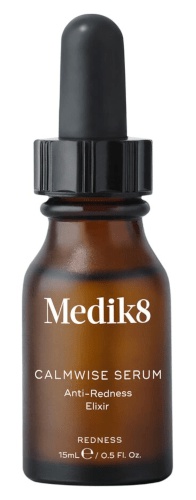
Calmwise Serum
Highlights
Skim through
| Ingredient name | what-it-does | irr., com. | ID-Rating |
|---|---|---|---|
| Simmondsia Chinensis Oil | emollient | 0, 0-2 | goodie |
| Cyclopentasiloxane | emollient, solvent | ||
| Caprylic/Capric Triglyceride | emollient | ||
| Cyclohexasiloxane | emollient, solvent | ||
| Tocopherol Acetate | antioxidant | 0, 0 | |
| Teprenone | cell-communicating ingredient | goodie | |
| Salvia Officinalis Extract | antioxidant, soothing, antimicrobial/antibacterial, surfactant/cleansing |
Medik8 Calmwise SerumIngredients explained
Jojoba is a drought resistant evergreen shrub native to South-western North America. It's known and grown for jojoba oil, the golden yellow liquid coming from the seeds (about 50% of the weight of the seeds will be oil).
At first glance, it seems like your average emollient plant oil: it looks like an oil and it's nourishing and moisturizing to the skin but if we dig a bit deeper, it turns out that jojoba oil is really special and unique: technically - or rather chemically - it's not an oil but a wax ester (and calling it an oil is kind of sloppy).
A super commonly used 5 unit long, cyclic structured silicone that is water-thin and does not stay on the skin but evaporates from it (called volatile silicone). Similar to other silicones, it gives skin and hair a silky, smooth feel.
It's often combined with the non-volatile (i.e. stays on the skin) dimethicone as the two together form a water-resistant, breathable protective barrier on the skin without a negative tacky feel.
A super common emollient that makes your skin feel nice and smooth. It comes from coconut oil and glycerin, it’s light-textured, clear, odorless and non-greasy. It’s a nice ingredient that just feels good on the skin, is super well tolerated by every skin type and easy to formulate with. No wonder it’s popular.
A light-feeling, volatile (meaning it does not absorb into the skin but evaporates from it) silicone that gives skin a unique, silky and non-greasy feel. It has excellent spreading properties and leaves no oily residue or build-up.
It’s the most commonly used version of pure vitamin E in cosmetics. You can read all about the pure form here. This one is the so-called esterified version.
According to famous dermatologist, Leslie Baumann while tocopheryl acetate is more stable and has a longer shelf life, it’s also more poorly absorbed by the skin and may not have the same awesome photoprotective effects as pure Vit E.
An anti-aging active ingredient that's claimed by its manufacturer to fight "all signs of aging" from dehydration, damaged skin barrier, and redness to age spots, wrinkles, and even pores. It works by telomere (the protecting end part of the chromosomes that get shorter during chromosome replication) stabilization and DNA maintenance and is claimed to be able to expand cell lifespan by a third. It might also improve the tissue quality by optimizing cell communication and cell metabolism.
The manufacturer did a simple blind study of 24 participants to back up these rather extraordinary claims. They found that 3% Renovage cream used for 6 months increased skin moisturization by 30-58% for all panelists, improved barrier integrity by 19-46% for 75% of panelists and fade UVsunspotss by 42 to 56% for all panelists.

You may also want to take a look at...
| what‑it‑does | emollient |
| irritancy, com. | 0, 0-2 |
| what‑it‑does | emollient | solvent |
| what‑it‑does | emollient |
| what‑it‑does | emollient | solvent |
| what‑it‑does | antioxidant |
| irritancy, com. | 0, 0 |
| what‑it‑does | cell-communicating ingredient |
| what‑it‑does | antioxidant | soothing | antimicrobial/antibacterial | surfactant/cleansing |





